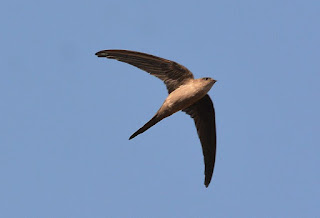Wing-Flapping Drones and Biomimetics
The word drone has many meanings, but is clarified by context. People drone on about boring subjects, a drone can be a mindless person, bagpipes and other instruments have single-note drone pipes, and more.
Our focus today uses what is arguably the most common defintion today, that of unmanned vehicles controlled remotely or by computers. (This child has embedded videos by drones (often called quadcopters) on this site several times.) Modern drones are impressive, but some researchers want to improve their performance.
 |
| Swift, Wikimedia Commons / Dr. Raju Kasambe (CC BY-SA 4.0) |
Researchers developed drones that are not flying with propellers. Instead, they fly with flapping — and they have some pretty impressive feats. The team studied birds, including swifts, because of the way they use their wings. As usual, however, imitations pale in comparison to the objects of study; our Creator's work still cannot be successfully imitated, let alone, replaced. Not a word of thanks to God, but praise goes to "nature."
Drawing inspiration from creation, a multinational research team (Singapore, China, Taiwan, and Australia) recently produced a new robotic drone that flaps its wings somewhat like a bird. This revolutionary design enables high-speed aerobatic manoeuvres once thought impossible for motorized drones. Mechanical flying machines that flap their wings are called ornithopters (from Greek ornithos, ‘bird’, and pteron, ‘wing’). By studying creatures that fly, the researchers were able to reverse-engineer some of their incredible aerodynamic and biomechanical abilities.
To read the whole article, see "Dynamic drones — Drawing inspiration from creation." Also of interest is a previous post, "Fantastic Flying Feathered Friends."